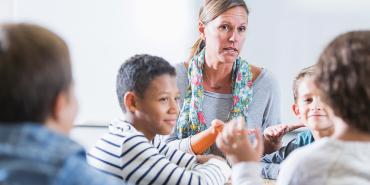Racism is not a new problem. It pervades our institutions, including our schools. It shows up in the books we read with our students and in the history we teach them—and in the omission of some heroes and events from those books and from our teaching.
When teachers see tangible examples of racism in the curriculum and in the way students treat each other, they can intervene and turn these instances into teachable moments. They can also be more intentional about teaching students to combat prejudice and practice tolerance, by incorporating resources from Share My Lesson and our partners.
Set Up Your Classroom for Success
To help students build trusting relationships with their peers, try engaging them in “The Heart Exercise.” Centered around the topic of bullying, this exercise takes students on an emotional journey (in small groups) that leads to deeper awareness of others’ experiences and greater compassion and understanding.
Also, take a look at your curriculum and ask yourself: “Does it leave out people of color?” If not, how are they presented? From there, you can make choices to include books with diverse characters in your curriculum content.
For book recommendations, visit Share My Lesson’s “PreK–12 Guide to Summer Reading Lists,” which features the Anti-Defamation League’s list of best multicultural and anti-bias books, with dozens of options for all ages.
Looking for lessons on certain themes or groups of people? Then visit Share My Lesson’s “Addressing Racism and Stereotyping” collection, which houses many content-based lessons on police brutality, lynching, and racial profiling, among other topics. Although some subjects may be uncomfortable to teach, addressing them head-on sends a message to students that such acts are wrong.
Do Your Homework
Before teaching content about racism or starting class discussions, you may want to learn more about the diverse experiences of people of color. Start by picking up Between the World and Me, a memoir by Ta-Nehisi Coates. Or join one of Share My Lesson’s webinars from our “Identity, Race, and the Classroom” series, with speakers from the AFT and Facing History and Ourselves.
For supporting students of color who identify as LGBTQ+ (lesbian, gay, bisexual, transgender, queer/questioning, plus), seek out resources to help you understand the vast range of backgrounds from which students come. For example, check out “Shared Differences: The Experiences of LGBT Students of Color in Our Nation’s Schools” from GLSEN (the Gay, Lesbian & Straight Education Network), Share My Lesson’s “Guide to Summer Reading for Teachers,” and Teaching for Change’s Social Justice Books project.
Start an Ongoing Conversation
Keep in mind that film can also be a powerful medium to spark classroom discussions. For instance, “Racism Is Real,” by Brave New Films, compares the experiences of two young men based on race. This digital clip and others like it are available in Share My Lesson’s racism collection.
To ensure you and your students are prepared for constructive conversations around race, consider reviewing the National Association of School Psychologists’ guide “Talking about Race and Privilege: Lesson Plan for Middle and High School Students.” Finally, keep in mind that these conversations will be difficult but are often rewarding, and that students’ attitudes won’t necessarily change in one class period but will evolve over time.
–THE SHARE MY LESSON TEAM

